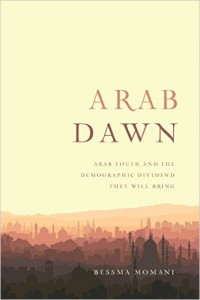Headlines perpetuate the one familiar story from the Arab world: “Canadian-Funded Clinic Destroyed” (Globe & Mail); “No Peace When War Never Ends” (Toronto Star); “Obama Outlines Military Plan” (Vancouver Sun); “Where ISIL Came From” (Montreal Gazette).
“In the West the Arab region of the Middle East and North Africa is all too often associated with terrorism, religious fanaticism, intolerance, sexism, racism, and a myriad of other social and political ills,” writes Prof. Bessma Momani of the University of Waterloo. Momani suggests there are two sides to every story – and in this case 350 million sides, representing the population of the Arab world.
They are typically young, media savvy, entrepreneurial and educated. The number of universities in the Arab region has more than doubled in fifteen years. In the United Arab Emirates 70 percent of post-secondary students are women. Momani quotes a Moroccan teen who laments the country’s education minister “doesn’t even have a bachelor’s degree”.
If newsgathering is an exercise in the depiction of fact, Arab Dawn is first-rate reportage. Drawn from first-hand travels and interviews with Arab students in Canada, Momani draws a three-dimensional picture much more satisfying than scanning the headlines. As the author quotes an old family proverb, “Add a hair to another hair and eventually you get a beard.”
A hit TV show in Qatar is Stars Of Science where young contestants build prototypes of patent-worthy inventions and viewers cast ballots for their favourite creation. The show is in its eighth season. “Winners are awarded hundreds of thousands of dollars in prizes,” Momani writes.
In Saudi Arabia teenagers play Unearthed, the first Arabic-language video game for Sony PlayStation 3 featuring a character named Faris and his sister Dania, an archaeologist in a hijab. Together they “embark on an exotic adventure throughout the Middle East on the trail of the famous Muslim explorer Ibn Battuta”, outwitting arms dealers and smugglers.
At the mall in Dubai is retailer DKNY’s “Ramadan Collection” featuring “colourful trench coats paired with trousers, khakis and stylish hijabs,” Arab Dawn reports. Mall cops keep an eye out for teenagers looking for dates.
“Arab society is changing from within – thanks to its youth, who are pushing it to become more competitive, accountable and cosmopolitan,” Momani writes. Eighty-seven percent own a mobile phone; 70 percent spend more than three hours a day online.
Arab Dawn is not an apologia, nor does it patronize readers with bland assurances that, really, Arab youth want to be just like their Canadian counterparts. “Many young Arabs find it perfectly compatible to identify as a person of faith who holds modern and progressive values such as wanting democracy, has a cosmopolitan identity, and respects individual liberties,” the author explains. “Similarly, Arab youth are capable of synthesizing a deep commitment to their families and communities and the pursuit of individual freedoms. They see no contradiction in the mixing of identities such as modern, Western, family-oriented, religious and Arab.”
Interviewing foreign students, Momani notes with interest those Canadian experiences that make the greatest impression: public transit, environmentalism, and law and order imposed without threat or favouritism. One Saudi scholar named Omar recounted with fascination his first brush with bylaw enforcement: “I got a parking ticket and I thought how amazing this was,” Omar said; “I felt this is what we need most in Saudi, law enforcement…I won’t park in an illegal spot again.”
Arab Dawn is an honest and persuasive profile of a newfangled society, the one they never show in the headlines.
By Holly Doan
Arab Dawn: Arab Youth & The Demographic Dividend They Will Bring, by Bessma Momani; University of Toronto Press; 176 pages; ISBN 9781-4426-28564; $14.27






